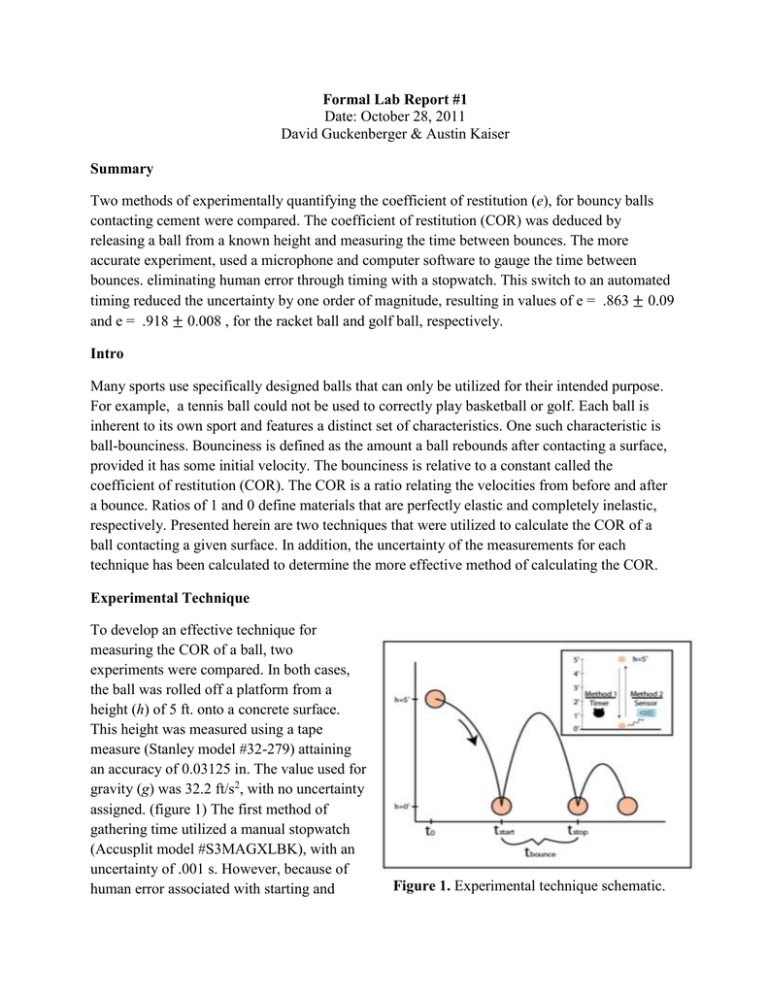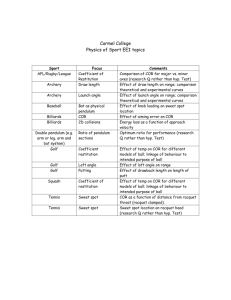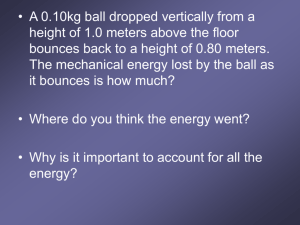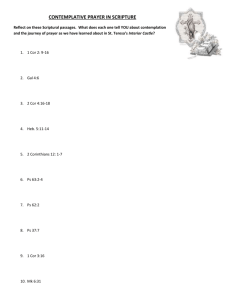Measurements Laboratory
advertisement

Formal Lab Report #1 Date: October 28, 2011 David Guckenberger & Austin Kaiser Summary Two methods of experimentally quantifying the coefficient of restitution (e), for bouncy balls contacting cement were compared. The coefficient of restitution (COR) was deduced by releasing a ball from a known height and measuring the time between bounces. The more accurate experiment, used a microphone and computer software to gauge the time between bounces. eliminating human error through timing with a stopwatch. This switch to an automated timing reduced the uncertainty by one order of magnitude, resulting in values of e = .863 ± 0.09 and e = .918 ± 0.008 , for the racket ball and golf ball, respectively. Intro Many sports use specifically designed balls that can only be utilized for their intended purpose. For example, a tennis ball could not be used to correctly play basketball or golf. Each ball is inherent to its own sport and features a distinct set of characteristics. One such characteristic is ball-bounciness. Bounciness is defined as the amount a ball rebounds after contacting a surface, provided it has some initial velocity. The bounciness is relative to a constant called the coefficient of restitution (COR). The COR is a ratio relating the velocities from before and after a bounce. Ratios of 1 and 0 define materials that are perfectly elastic and completely inelastic, respectively. Presented herein are two techniques that were utilized to calculate the COR of a ball contacting a given surface. In addition, the uncertainty of the measurements for each technique has been calculated to determine the more effective method of calculating the COR. Experimental Technique To develop an effective technique for measuring the COR of a ball, two experiments were compared. In both cases, the ball was rolled off a platform from a height (h) of 5 ft. onto a concrete surface. This height was measured using a tape measure (Stanley model #32-279) attaining an accuracy of 0.03125 in. The value used for gravity (g) was 32.2 ft/s2, with no uncertainty assigned. (figure 1) The first method of gathering time utilized a manual stopwatch (Accusplit model #S3MAGXLBK), with an uncertainty of .001 s. However, because of human error associated with starting and Figure 1. Experimental technique schematic. stopping the stopwatch when the ball hits the ground, the time uncertainty is on the order of .06 s. Therefore, method two was derived to eliminate human error. A microphone (Shure model #SM58)(uncertainty ~.010 s.) was incorporated with LabVIEW (National Instruments, myDAQ) to record the time between the bounces. The microphone detected the sound from bounces one and two. Simultaneously, the software started a timer at bounce one and stopped it at bounce two, giving a more accurate measure of time. Both methods were conducted using a golf ball (Snake Eyes) and a racket ball (Penn Ultra Blue), to confirm that data between the two experimental techniques were similar. Data Reduction In order to calculate the velocity of a falling ball, measurements of height and time were needed. The resulting COR was calculated as the ratio of velocities before and after impact with the ground. The COR(e) equation was derived from Newton’s Law and Conservation of Energy Theory (Equation 1). e= 𝑡𝑏𝑜𝑢𝑛𝑐𝑒 2 𝑔 √2ℎ (1) The uncertainty of the height measurement (uh) is one half of the resolution of the tape measure, making uh = 1/32 in. The uncertainty of time is the product of the standard deviation of the time and the student t value (tv,95)(equation 2). 𝑈𝑡 = 𝑡𝑣 ,95 ∗ 𝑠𝑡 , 𝑤ℎ𝑒𝑟𝑒 𝑣 = 𝑁 − 1 (2) A 95% confidence interval was used for all uncertainty calculations, where 21 measured of bounce time (N) were taken to reduce the overall uncertainty. The Root Sum Square method was used for the propagations of uncertainty (equations 3 – 5). 𝜕𝑒 1 𝑔 Ue, t = 𝜕𝑡 * Ut = 2 *√2ℎ * Ut 𝜕𝑒 Ue, h = 𝜕ℎ * Uh = −𝑡√𝑔 3 4(2ℎ) ⁄2 Ue = √𝑈𝑒,𝑡 2 + 𝑈𝑒,ℎ 2 * Uh (3) (4) (5) Measurements and calculations summarizing the data reduction results available in the Appendix (table 1). Results The two methods of measuring COR demonstrated a drastic different of uncertainty. The COR calculated for the racket ball and golf ball using the manual timer method were 0.87 ± 0.05 and 0.90 ± 0.06, respectively. Similarly, the COR calculated for the racket ball and golf ball using a microphone was 0.863 ± 0.009 and 0.918 ± 0.008, respectively. The calculated COR is comparable in both methods, and as expected, the COR of the golf ball is closer to one than that of a racket ball, due to the elastic nature of the golf ball. However, the uncertainties of the two methods differ by an order of magnitude. This difference is most likely due to the human error inherent to manually timing with a stop watch, in addition to the delay between pressing the button and the timer actually stopping. To confirm the effectiveness of the technique, two different balls were used in both methods, and the height was varied. The use of two balls, and visual verification of the COR similarity between methods demonstrated the consistency between methods. To further verify that the microphone method was effective, a golf ball was released from 6ft instead of 5ft, and the COR came out to be 0.911 ± 0.011, which falls between the values calculated in the previous methods. The results of the calculated COR for the microphone experiment are demonstrated in the histograms (figure 2). Results for data determined by manually timing the bounces are available in the appendix (figure 3 – A3). Figure 2. COR frequency taken with the microphone Appendix A1: Actual Data for microphone measurements Golf Ball Freq Dist 0.231 0.192 0.385 0.077 0.077 # Norm Hist 80 67 134 27 27 Norm Dist 73 105 85 39 10 T (sec) e Bins Freq 1 1.019 0.914 0.914 6 2 1.022 0.917 0.917 5 3 1.025 0.920 0.920 10 4 1.020 0.915 0.923 2 5 1.017 0.912 0.926 2 6 1.016 0.912 7 1.023 0.918 Statistics 8 1.018 0.913 9 1.021 0.916 t (sec) e 10 1.022 0.917 min 1.016 0.912 11 1.022 0.917 max 1.032 0.926 12 1.024 0.919 ave 1.023 0.918 13 1.023 0.918 stdev 0.004 0.004 14 1.023 0.918 count 21 21 15 1.023 0.918 Bins 4.559 4.559 16 1.024 0.919 Bins 5 5 17 1.032 0.926 Bin Size 0.0032 0.002871 18 1.017 0.912 T_value 2.086 19 1.031 0.925 20 1.027 0.921 21 1.023 0.918 22 1.025 0.920 23 1.017 0.912 24 1.028 0.922 25 1.023 0.918 A2 – Uncertainty Propagation of microphone timed data: 26 1.029 0.923 MICROPHONE: 1. Racket Ball from height (h) = 5 ft. Uh = 0.0625 Ue, t = 1 2 *√ Avg. time (t) = 0.96 s C.O.R. (e) = 0.86 Ut = 2.086*St= 2.086 * 0.005= 0.010 32.2 2∗5 * 0.010 =.009 Ue = √0.0092 + (−0.0014)2 = Ue, h = .0091 −0.96√32.2 3 4(2∗5) ⁄2 * 0.03125 = -0.0014 2. Golf Ball from height (h) = 5 ft. 0.918 Uh = 0.0625 Ue, t = 1 2 *√ Avg. time (t) = 1.023 s Ut = 2.086*St= 2.086 * .004= 0.009 32.2 2∗5 * 0.009 = 0.0081 Ue, h = −1.023√32.2 3 4(2∗5) ⁄2 Ue = √0.00812 + (−0.0014)2 = .0082 A3: Frequency of manually timed data Figure 3. COR results from stopwatch experiment * 0.003125 = -0.0014 C.O.R. (e) =







